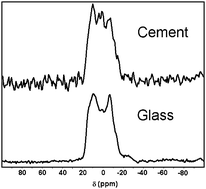Aluminoborosilicate glasses of general composition (0.14 − x/2.2)SiO2:(0.07 − x/4.2)B2O3:(0.09 − x/3.3)Na2O:0.40CaO:xAl2O3 (0.00 ≤ x ≤ 0.30) were synthesised using standard melt quenching methods and analysed by 11B, 23Na, 27Al and 29Si solid-state nuclear magnetic resonance (NMR) spectroscopy. Calculations based on electroneutrality considerations were used to check the consistency of the NMR assignments in both glasses and cements. Glass–ionomer cement (GIC) formation was tested with all the prepared glass compositions, but only the samples with higher concentrations of Al2O3, x ≥ 0.20, produced sustainable cements. The compressive strengths (CS) of the cements varied from 66.7 to 74.2 MPa, although the differences were not statistically significant. The leaching of aluminium from the glass into the cement matrix varied between 6 and 12 mol%. It is proposed that aluminium plays a key role in glass–ionomer cements, not only through leaching of Al3+ ions from the glass into the cement matrix during formation, but also through reinforcement of the resulting cement by the residual glass particles which have high alumina content and confer greater mechanical strength.

You have access to this article
 Please wait while we load your content...
Something went wrong. Try again?
Please wait while we load your content...
Something went wrong. Try again?


 Please wait while we load your content...
Please wait while we load your content...